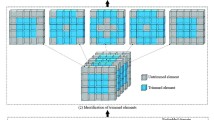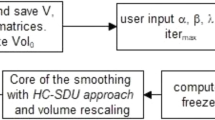Abstract
The computer-aided design model reconstruction process is generally very complex, as it requires substantial efforts in planning and editing data points, curves, and surfaces. A novel method is developed in this study for automatic surface reconstruction from a huge number of triangular meshes. The proposed method is mainly composed of the following five steps: mesh simplification, quadrilateral mesh generation, curve net construction, connectivity data preparation, and multiple surfaces fitting with G1 continuity across the boundaries. The first three steps build the boundary curves of the surfaces. The fourth step prepares the data needed for surface fitting, which includes segmented points, continuity conditions on the boundaries, and topological relationship of the data. In the final step, all regions of points are fitted into appropriate surfaces, with the accuracy and smoothness of the surfaces controlled and G1 continuity between the surfaces. A detailed discussion for each of the above algorithms is provided. Successful examples are also presented to demonstrate the feasibility of the proposed method.
Similar content being viewed by others
References
Alhanaty M, Bercovier M (2001) Curve and surface fitting and design by optimal control methods. CAD 33:167–182
Weiss V, Andor L, Renner G, Varady T (2002) Advanced surface fitting techniques. CAGD 19:19–42
Pottmann H, Leopoldseder S (2003) A concept for parametric surface fitting which avoids the parameterization problem. CAGD 20:343–362
Eck M, Hoppe H (1996) Automatic reconstruction of B-Spline surfaces of arbitrary topological type. In: Proceedings of SIGGRAPH ’96, pp 209–216
Ying H, Hong Q (2004) Surface reconstruction with triangular B-splines. In: Proceedings of Geometric Modeling, pp 47–58
Ma W, Zhao N (2000) Catmull–Clark surface fitting for reverse engineering applications. In: Proceedings of Geometric Modeling, pp 274–283
Schroeder W, Zarge J, Lorensen W (1992) Decimation of triangle meshes. Proc SIGGRAPH ’92 26:65–70
Cohen J, Varshney V, Manocha D, Turk G, Weber H (1996) Simplification envelopes. In: Proceedings of Computer Graphics, ACM SIGGRAPH, pp 119–128
Hoppe H (1996) Progressive meshes. In: Proceedings of SIGGRAPH ’96, pp 99–108
Garland M, Heckbert P (1997) Surface simplification using quadric error metrics. In: Proceedings of SIGGRAPH ’97, pp 209–216
Garland M, Zhou Y (2005) Quadric-based simplification in any dimension. ACM Trans Graph 24(2):209–239, doi:10.1145/1061347.1061350
Lau TS, Lo SH, Lee CK (1997) Generation of quadrilateral mesh over analytical curved surface. Finite Elem Anal Des 27:251–272, doi:10.1016/S0168-874X(97)00015-2
Kobbelt L (1996) Interpolatory subdivision on open quadrilateral nets with arbitrary topology. Eurographics Assoc 15(3):C409–C420
Borouchaki H, Frey P (1998) Adaptive triangular–quadrilateral mesh generation. Int J Numer Methods Eng 41:915–934, doi:10.1002/(SICI)1097-0207(19980315)41:5<915::AID-NME318>3.0.CO;2-Y
Maza S, Noel F, Leon JC (1999) Generation of quadrilateral meshes on free-form surface. Comput Struct 71:505–524, doi:10.1016/S0045-7949(98)00300-9
Lee KY, Kim II, Cho DY, Kim TW (2003) An algorithm for automatic 2D quadrilateral mesh generation with line constraints. CAD 35:1055–1068
Milroy MJ, Bradly C, Vickers GW, Weir DJ (1995) G1 continuity of B-spline surface patches in reverse engineering. CAD 27(6):471–478
Chen KJ, Tsai YC, Lai JY, Ueng WD (2007) B-spline surface fitting of random points with constrained boundary conditions. Int J Comput Appl Technol 30(4):295–308, doi:10.1504/IJCAT.2007.017241
Lai JY, Ueng WD (2001) G2 Continuity for multiple surfaces fitting. Int J Adv Manuf Technol 17:575–585, doi:10.1007/s001700170141
Du WH, Schmitt FJM (1990) On the G1 continuity of piecewise Bezier surfacs: a review with new results. CAD 22:556–573
Sarraga RF (1987) G1 interpolation of generally unrestricted cubic Bezier curves. CAGD 4:23–39
Leong KF, Chua CK, Ng YM (1996) A study of StereoLithography file errors and repair. Part I: Generic solutions. Int J Adv Manuf Technol 12:407–414, doi:10.1007/BF01186929
Leong KF, Chua CK, Ng YM (1996) A study of StereoLithography file errors and repair. Part II: Special cases. Int J Adv Manuf Technol 12:415–422, doi:10.1007/BF01186930
Lai JY, Shu SH (2007) On the development of a hole filling algorithm for triangular meshes. JCIE 30(5):877–889
Taubin G (1995) A signal processing approach to fair surface design. In: Proceedings of SIGGRAPH ’95, pp 351–358
Hubeli A, Meyer K, Gross MH (2000) Mesh edge detection. Technical report 351, ETH Zu”rich, Institute of Computer Systems
Guskov I, Sweldens W, Schröder P (1999) Multi-resolution signal processing for meshes. In: Proceedings of SIGGRAPH ’99, pp 325–334
Pearl J (1984) Heuristics intelligent search strategies for computer problem solving. Addison-Wesley, Boston, MA
Russell S, Norving P (2003) Artificial intelligence: a modern approach. Prentice Hall, Upper Saddle River, NJ
Ueng WD, Lai JY, Tsai YZ (2006) Unconstrained and constrained curve fitting for reverse engineering. Int J Adv Manuf Technol 33:1189–1203, doi:10.1007/s00170-006-0557-8
Lee K (1999) Principles of CAD/CAM/CAE systems. Addison-Wesley, Reading, MA
Piegl L, Tiller W (1997) The NURBS book. Springer, New York
Author information
Authors and Affiliations
Corresponding author
Rights and permissions
About this article
Cite this article
Tsai, YC., Huang, CY., Lin, KY. et al. Development of automatic surface reconstruction technique in reverse engineering. Int J Adv Manuf Technol 42, 152–167 (2009). https://doi.org/10.1007/s00170-008-1586-2
Received:
Accepted:
Published:
Issue Date:
DOI: https://doi.org/10.1007/s00170-008-1586-2




